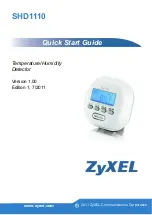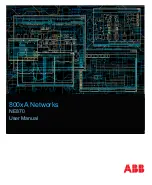
Appendix C IPv6
Nebula Mobile Router User’s Guide
339
receives a neighbor advertisement in response, it stores the neighbor’s link-layer address in the neighbor
cache. When the Zyxel Device uses a router solicitation message to query for a router and receives a
router advertisement message, it adds the router’s information to the neighbor cache, prefix list and
destination cache. The Zyxel Device creates an entry in the default router list cache if the router can be
used as a default router.
When the Zyxel Device needs to send a packet, it first consults the destination cache to determine the
next hop. If there is no matching entry in the destination cache, the Zyxel Device uses the prefix list to
determine whether the destination address is on-link and can be reached directly without passing
through a router. If the address is unlink, the address is considered as the next hop. Otherwise, the Zyxel
Device determines the next-hop from the default router list or routing table. Once the next hop IP
address is known, the Zyxel Device looks into the neighbor cache to get the link-layer address and sends
the packet when the neighbor is reachable. If the Zyxel Device cannot find an entry in the neighbor
cache or the state for the neighbor is not reachable, it starts the address resolution process. This helps
reduce the number of IPv6 solicitation and advertisement messages.
Multicast Listener Discovery
The Multicast Listener Discovery (MLD) protocol (defined in RFC 2710) is derived from IPv4's Internet
Group Management Protocol version 2 (IGMPv2). MLD uses ICMPv6 message types, rather than IGMP
message types. MLDv1 is equivalent to IGMPv2 and MLDv2 is equivalent to IGMPv3.
MLD allows an IPv6 switch or router to discover the presence of MLD listeners who wish to receive
multicast packets and the IP addresses of multicast groups the hosts want to join on its network.
MLD snooping and MLD proxy are analogous to IGMP snooping and IGMP proxy in IPv4.
MLD filtering controls which multicast groups a port can join.
MLD Messages
A multicast router or switch periodically sends general queries to MLD hosts to update the multicast
forwarding table. When an MLD host wants to join a multicast group, it sends an MLD Report message
for that address.
An MLD Done message is equivalent to an IGMP Leave message. When an MLD host wants to leave a
multicast group, it can send a Done message to the router or switch. The router or switch then sends a
group-specific query to the port on which the Done message is received to determine if other devices
connected to this port should remain in the group.
Example – Enabling IPv6 on Windows 10
Windows 10 supports IPv6 by default. DHCPv6 is also enabled when you enable IPv6 on a Windows 10
computer.
To enable IPv6 in Windows 10:
1
Click the start icon,
Settings
and then
Network & Internet
.
2
Select the
Internet Protocol Version 6 (TCP/IPv6)
checkbox to enable it.
3
Click
OK
to save the change.
Summary of Contents for LTE3301-PLUS
Page 16: ...16 PART I User s Guide...
Page 43: ...Chapter 3 Web Configurator Nebula Mobile Router User s Guide 43 Figure 31 Connection Status...
Page 50: ...Chapter 3 Web Configurator Nebula Mobile Router User s Guide 50 Figure 36 Check Icons...
Page 89: ...Nebula Mobile Router User s Guide 89 PART II Technical Reference...
Page 361: ...Index Nebula Mobile Router User s Guide 361 Zyxel Nebula Control Center 18...
















































